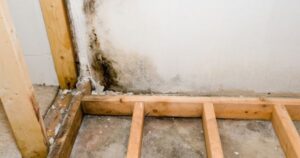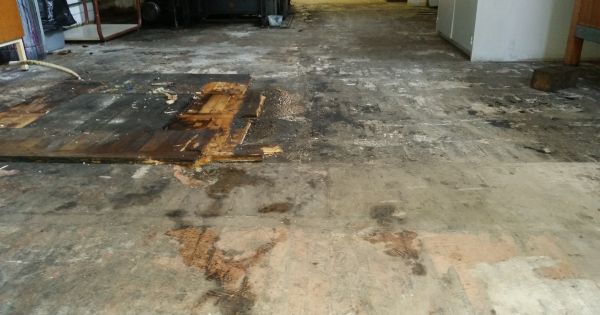Water damage under the floor is often a hidden threat that, if left unattended, can lead to severe consequences. Recognizing early signs is critical for preventing structural issues and health hazards, especially in areas like Draper, UT, where water damage concerns are prevalent. Neglecting these issues not only results in costly repairs but can also affect the integrity of your living environment. As we explore the indicators and the challenges of returning home after a flood, the importance of monitoring utility bills, and the need for professional inspections, it becomes clear that a proactive approach is essential. In this blog, we delve into the basic yet crucial details of identifying and addressing water damage under the floor. We empower you to safeguard your home and family with the solution for your water damage restoration in Draper UT.
What Are the Signs of Water Damage Under Floor?
Water damage under the floor can be a silent threat, often lurking unnoticed until significant damage has already occurred. Whether caused by leaks, floods, or other sources of moisture, water damage beneath the floor can affect the structural integrity of your home and pose health risks to its occupants. Recognizing the early signs of water damage is crucial for preventing further escalation of the problem. In this section, we will explore the telltale indicators that water damage may be present under your floors.
- Visual Indicators

When it comes to signs of water damage under the floor, visual cues play a crucial role. Look out for discoloration, warping, or buckling of flooring materials. Inspecting changes in color or texture on hardwood, laminate, or tile floors can provide early indications of potential water damage issues. Keep an eye out for any standing water or moisture accumulation around these areas, as it may worsen the damage over time. Look for gaps between floorboards or tiles, as well as any signs of warping along the edges. These visual cues can provide valuable insights into the extent of water damage and help guide remediation efforts.
- Unpleasant Odors
Water damage often brings unwelcome odors into your home. Musty or moldy smells can be indicators of hidden water damage. Tips for recognizing these unusual smells can help you pinpoint the source and address the issue quickly. Pay attention to any persistent odors even after cleaning, as they may signal a remaining moisture problem that needs attention. Any odors reminiscent of rotting wood or sewage can indicate more severe issues requiring immediate attention. Additionally, consider using odor-detecting tools or devices to pinpoint the source of the smell accurately and address it effectively.
- Soft or Squishy Spots
Subflooring weakened by water damage can result in soft or squishy spots. Detecting these areas is as simple as walking or pressing on different parts of the floor. If you notice any changes in the floor’s integrity, it’s time to investigate further. Pay special attention to areas near potential water sources, such as bathrooms or kitchens, where soft spots may be more likely to develop. When assessing soft or squishy spots on the floor, take note of any areas that feel unusually damp or cool to the touch. Use a moisture meter to measure the moisture content of the affected areas, as elevated moisture levels can indicate ongoing water damage.
- Mold Growth

The connection between water damage and mold growth is undeniable. Understanding how to recognize visible mold and being aware that it might be present even if not immediately visible is essential for addressing this issue. In addition to visible mold growth, be on the lookout for any signs of mold spores or fungal growth in the surrounding areas. Inspect the walls, baseboards, and nearby furniture for any discoloration or staining that may indicate mold colonization. Consider using a flashlight to illuminate dark or hidden spaces where mold may grow, such as behind furniture or inside closets, to ensure a thorough inspection.
- Peeling or Bubbling Floor Coverings
Excess moisture can cause floor coverings like vinyl or linoleum to peel or bubble. Inspecting these signs in areas prone to water exposure can help you catch water damage before it becomes a more significant issue. Be thorough in your examination, paying attention to seams and edges, as these are common areas where moisture can seep through, leading to peeling or bubbling. Look for areas where the floor covering appears brittle or cracked, as these can indicate long-term water damage. Besides that, inspect the subfloor beneath the affected areas for any signs of moisture infiltration or structural compromise, as addressing these underlying issues is essential for effective remediation.
Challenges of Post-Flood
Returning home after flood brings unique challenges. This includes potential water damage issues that may arise. Upon your return, take the time to inspect the floor and subfloor for damage, ensuring a thorough examination to address any hidden problems. This proactive approach can help mitigate further damage and ensure the safety of your home.
Importance of Monitoring Increased Utility Bills
Increased water bills may mean you have a hidden leak causing water damage under floors. Monitoring utility bills for sudden spikes is crucial, as these may indicate a hidden water leak that requires immediate attention. In addition, keeping track of other utility costs like electricity and gas can also provide insights into potential water damage issues, as excessive moisture can impact various systems in your home.
Professional Inspection with Summit Restoration
Recognizing signs of water damage under the floor is crucial for maintaining a safe and structurally sound home. Quick action is essential to prevent further issues and costly repairs. If you suspect water damage but can’t identify the source, seeking professional help is essential. Our IICRC-certified water damage restoration professionals at Summit Restoration can provide a comprehensive assessment and guide you through the necessary steps for restoration. Call (385) 469-2638 or submit the form on our website for a free estimate!






